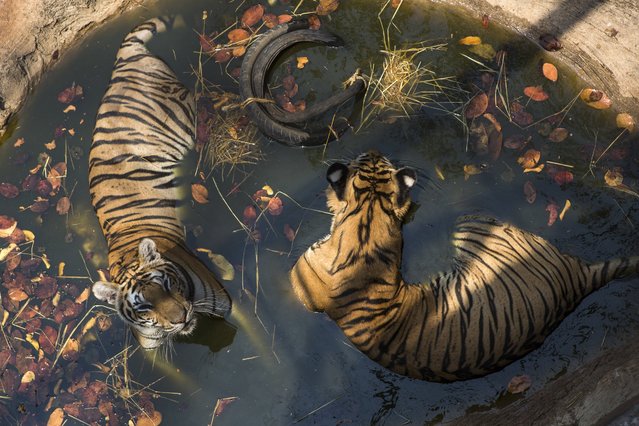
A pair of tigers soak in a shallow pool at Tiger Temple, a Buddhist monastery where paying visitors can interact with young adult tigers, in Kanchanaburi, Thailand, March 16, 2016. The attraction, near the Myanmar border, started collecting the animals 15 years ago when villagers brought an injured tiger cub to the local abbot, who agreed to care for it. Today there are nearly 150 tigers at the monastery. (Photo by Amanda Mustard/The New York Times)
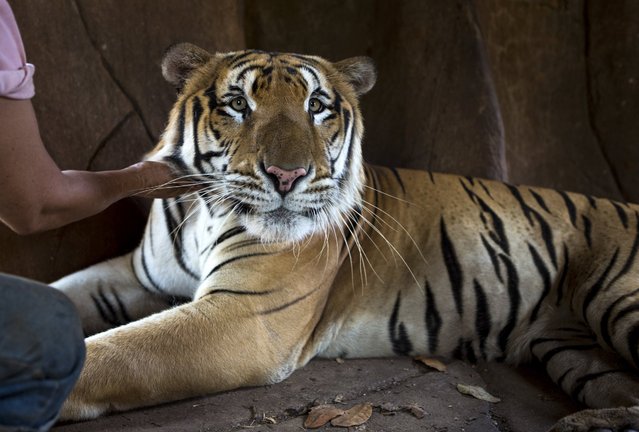
A handler rubs a tiger's cheek at Tiger Temple, a Buddhist monastery where paying visitors can interact with young adult tigers, in Kanchanaburi, Thailand, March 16, 2016. The tourist attraction has long been the bane of conservationists and animal rights activists who accuse it of abuse and exploitation. (Photo by Amanda Mustard/The New York Times)
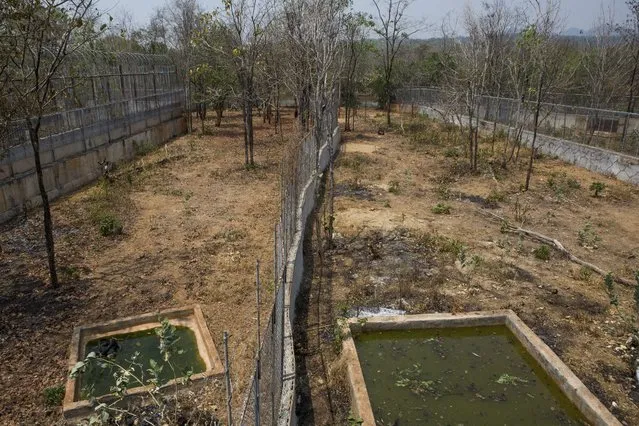
Outdoor pens where tigers are sometimes kept at Tiger Temple, a Buddhist monastery where paying visitors can interact with young adult tigers, in Kanchanaburi, Thailand, March 16, 2016. (Photo by Amanda Mustard/The New York Times)

Tigers in outdoor pens where they are sometimes kept at Tiger Temple, a Buddhist monastery where paying visitors can interact with young adult tigers, in Kanchanaburi, Thailand, March 16, 2016. Only tigers under age 4 – there are 16 of them now – are brought out for tourists. Larger tigers are retired to cages. (Photo by Amanda Mustard/The New York Times)
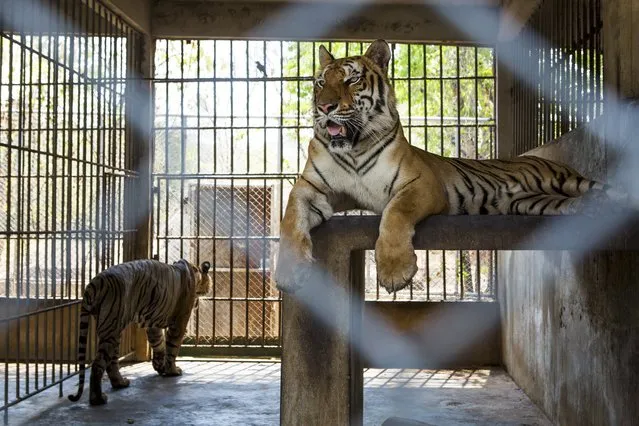
Tigers in an enclosure at Tiger Temple, a Buddhist monastery where paying visitors can interact with young adult tigers, in Kanchanaburi, Thailand, March 16, 2016. (Photo by Amanda Mustard/The New York Times)
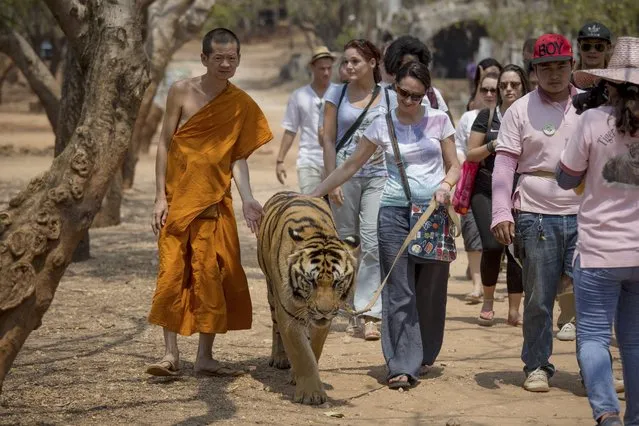
A monk walks along with a visitor who has paid to walk a tiger on a leash, at Tiger Temple in Kanchanaburi, Thailand, March 16, 2016. The 15 or so monks who live on the grounds have little to do with the tigers beyond occasionally posing with them for tourists. (Photo by Amanda Mustard/The New York Times)
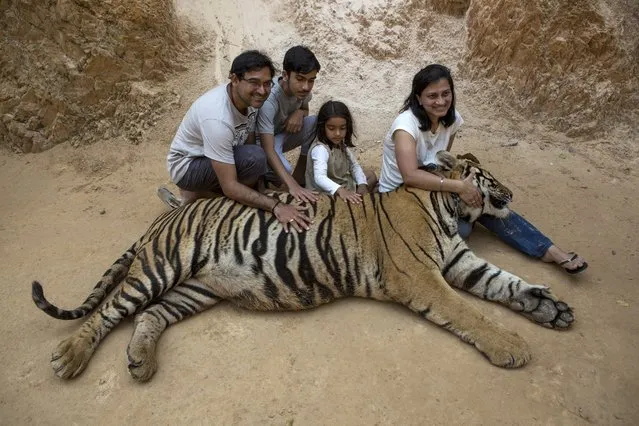
Visitors pose for photos at Tiger Temple in Kanchanaburi, Thailand, March 16, 2016. After complaints of trafficking in endangered species, the government is trying to shut down the attraction, and began removing the animals this year, but was ordered to stop after the temple filed a lawsuit in February. (Photo by Amanda Mustard/The New York Times)

Souvenir plastic “tiger teeth” at Tiger Temple, a Buddhist monastery where paying visitors can interact with young adult tigers, in Kanchanaburi, Thailand, March 16, 2016. The temple takes in $5.7 million a year from ticket sales, wildlife officials say, and receives millions more in donations. (Photo by Amanda Mustard/The New York Times)
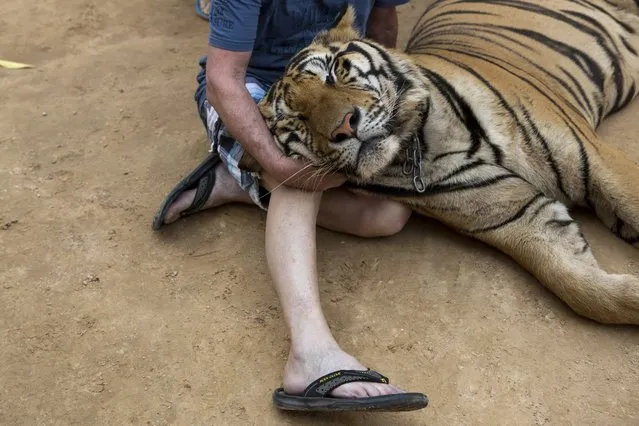
A visitor sits with a tiger's head in their lap at Tiger Temple, a Buddhist monastery where paying visitors can interact with young adult tigers, in Kanchanaburi, Thailand, March 16, 2016. (Photo by Amanda Mustard/The New York Times)
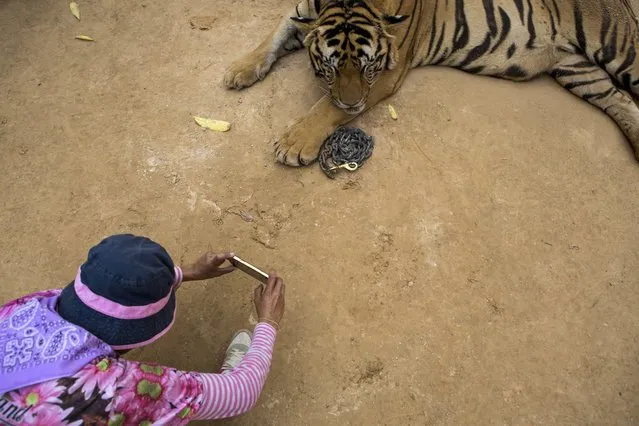
A staff member photographs a visitor with one of the big cats at Tiger Temple, in Kanchanaburi, Thailand, March 16, 2016. “We built this temple to spread Buddhism”, said Supitpong Pakdjarung, a former police colonel who runs the temple's business arm. “The tigers came by themselves”. (Photo by Amanda Mustard/The New York Times)
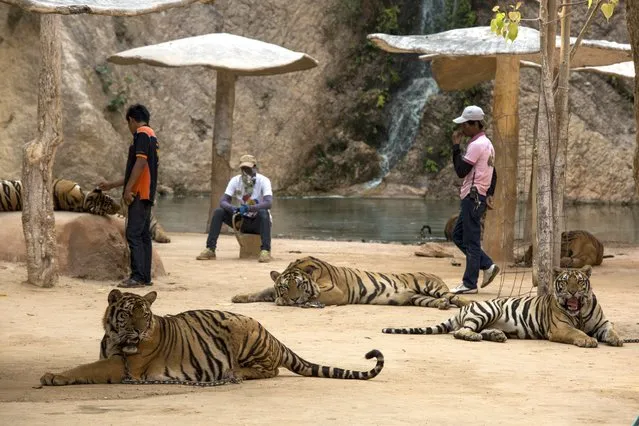
Staff members wait in Tiger Canyon, where visitors can have their photo taken with the big cats, at Tiger Temple in Kanchanaburi, Thailand, March 16, 2016. The temple promotes itself as a place where tigers betray their wild nature to coexist with humans in Buddhist harmony, and some monks and staff members believe that certain tigers are reincarnated monks or family members. (Photo by Amanda Mustard/The New York Times)
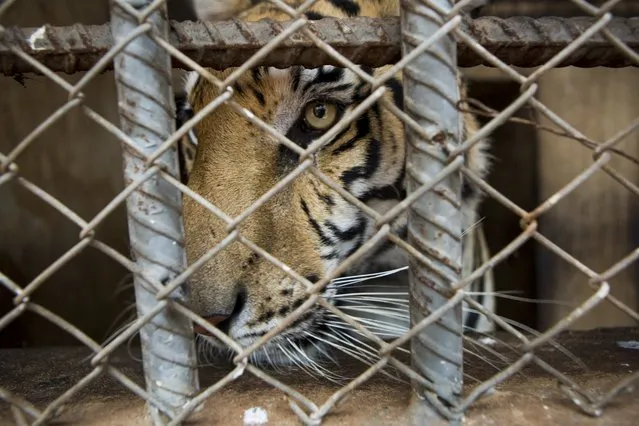
A tiger in an enclosure at Tiger Temple, a Buddhist monastery where paying visitors can interact with young adult tigers, in Kanchanaburi, Thailand, March 16, 2016. (Photo by Amanda Mustard/The New York Times)

A toothsome yawn in an area called Tiger Canyon, where visitors can have their photo taken, at Tiger Temple in Kanchanaburi, Thailand, March 16, 2016. The temple promotes itself as a place where tigers betray their wild nature to coexist with humans in Buddhist harmony, and some monks and staff members believe that certain tigers are reincarnated monks or family members. (Photo by Amanda Mustard/The New York Times)
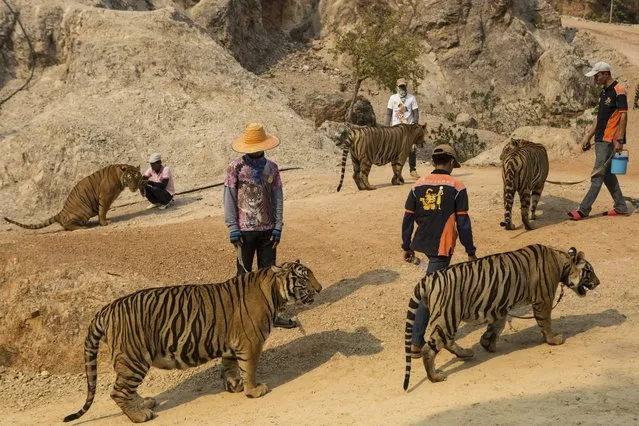
Staff walk several tigers back to enclosures after an afternoon of photography sessions with visitors to Tiger Temple in Kanchanaburi, Thailand, March 16, 2016. The government has ordered the temple to stop breeding tigers, charging fees to tourists and letting visitors feed tigers, officials say, but the temple has refused. (Photo by Amanda Mustard/The New York Times)
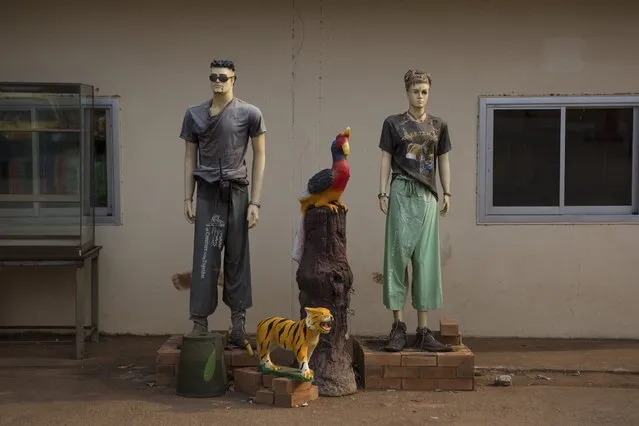
Mannequins with shirts and other souvenir clothing items for sale at Tiger Temple, where for a premium admission a visitor can bathe a tiger and even bottle-feed a cub, in Kanchanaburi, Thailand, March 16, 2016. (Photo by Amanda Mustard/The New York Times)

A new building project at Tiger Temple, a Buddhist monastery where paying visitors can interact with young adult tigers, in Kanchanaburi, Thailand, March 16, 2016. (Photo by Amanda Mustard/The New York Times)
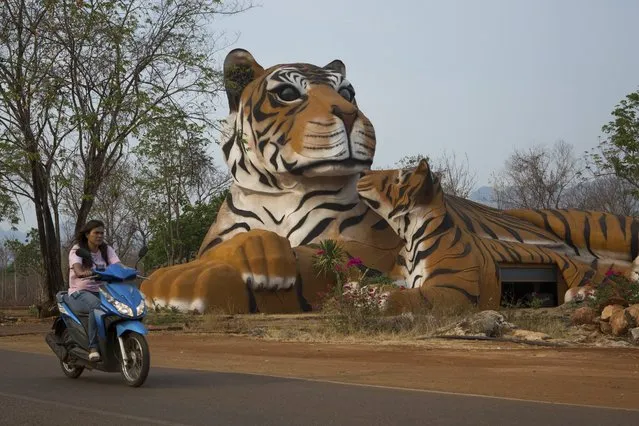
A building in the shape of a tiger mother and cub at the entrance to Tiger Temple, a Theravada Buddhist temple and monastery where paying visitors can pet and stroll with tigers, in Kanchanaburi, Thailand, March 16, 2016. (Photo by Amanda Mustard/The New York Times)
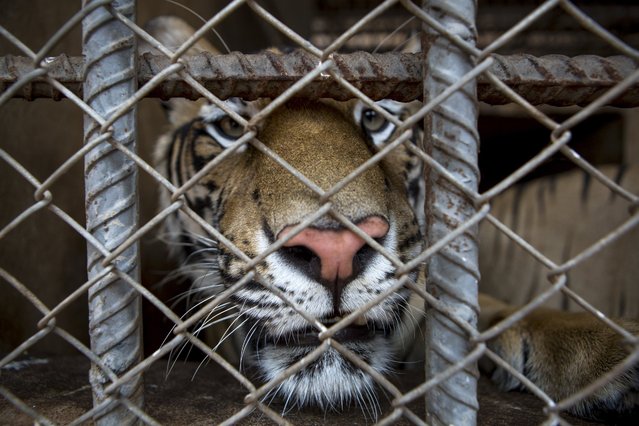
A tiger in an enclosure at Tiger Temple, a Buddhist monastery where paying visitors can interact with young adult tigers, in Kanchanaburi, Thailand, March 16, 2016. (Photo by Amanda Mustard/The New York Times)
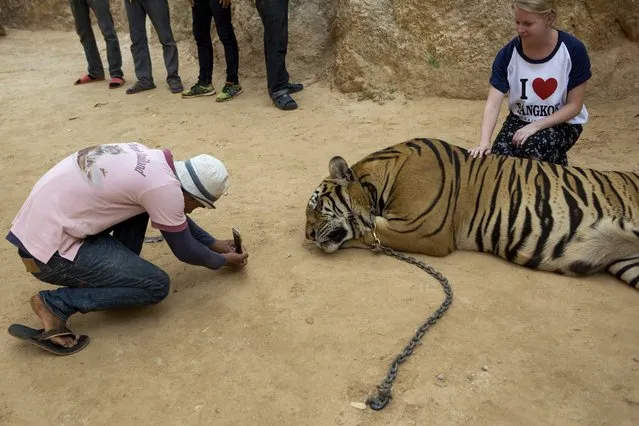
A staff member photographs a visitor with one of the big cats at Tiger Temple, in Kanchanaburi, Thailand, March 16, 2016. (Photo by Amanda Mustard/The New York Times)
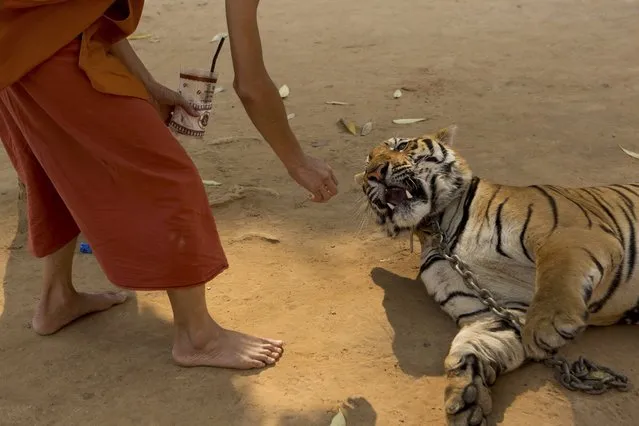
A monk feeds one of the big cats an ice cube from his drink at Tiger Temple, in Kanchanaburi, Thailand, March 16, 2016. (Photo by Amanda Mustard/The New York Times)
04 May 2016 12:08:00,
post received
0 comments
